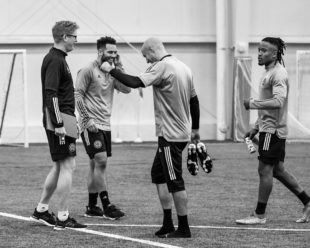Photo: Marjorie Elzey
There are many questions surrounding the return of MLS in July. One of which is how the players will fare having to play after a long layoff. Injury concerns are valid particularly with the lack of organized and monitored training that was able to occur while the world was largely locked down. I want to touch on a few things that will hopefully give a better idea of what to expect in terms of injury risk. I will not be touching on COVID concerns in this article, as it is well above my pay grade to make assertions on that front.
It is reasonable to think players will be at risk of injury after three-ish months away from organized club activities. The greatest risk is soft tissue injury, which largely comes down to whether or not the players truly kept up with their fitness while isolated. Soft tissue injuries occur, simply put, when the involved tissue is pushed beyond what it is physically able to perform.
What makes a tissue not able to perform its job you ask? That is not so simply put. The strength, mobility, and endurance of the muscle all play a role, along with the player’s overall nutrition including sleep, hydration, dietary intake. Even with virtual contact, the fact that players were not consistently coached and monitored by athletic trainers, therapists, team physicians, strength and conditioning coaches in person leaves a lot of unknown variables. We will be able to see early in the tournament which players in the league did their homework.
On the positive side the league, in collaboration with the player’s union, did a good job to mitigate some complicating factors. The 9 a.m., 8 p.m., and 10:30 p.m. start times were done partly to avoid the scorching Central Florida sun at 1 p.m. in mid-July. The players also will have approximately 4 weeks with the team leading up to the tournament. I would imagine the staff is using this time to compare data from just prior to the season – things like percent body fat, weight, and heart rate during training – to current data. Lastly, there will be a total of five subs allowed for each game at the tournament. This will help manage the minutes on player’s legs as the get back into full match fitness.
News recently came out regarding the facilities available to MLS clubs while staying in at their respective Disney properties. Concerns had previously been raised about the ability to properly manage player health when the clubs are used to having private (and in some cases extensive) access to top of the line equipment for recovery and maintenance between matches. Compounding the issue is the shortened time period between group stage matches. Normally clubs typically have six to seven days between matches with occasional midweek matches. At the tournament the period between matches will be closer to four or five days.
Teams will have access to one of ten training centers for at least two hours per day and two lap pools are available solely for player management. While the training centers are described having “a full range of equipment” they will likely not be up to the standards of clubs with top level facilities. This will require the coaching, medical, and training staffs to all be collaborating on how to best manage these players. In addition, the shortened time between matches is countered by the fact there is no travel to be done between matches. Six or seven days between matches in Seattle and New England is very different than four or five days staying in one location.
What does this all mean for the Union? Overall the Union are well set up for the tournament physically. As far as we know, they come into the tournament with every player available. Even the mysterious preseason injuries of Kai Wagner have healed according to Kai himself. He stated “100% back on the pitch” in an Instagram post on May 28. The U also have serious depth in most positions, with outside back being perhaps the lone thin spot. This tournament will be influenced much more than usual by managerial decisions with the extra subs. I wouldn’t be surprised to see Jim Curtin limit the minutes initially of players like Alejandro Bedoya who are a little older and have dealt with soft tissue injuries in the past, especially with the shortened rest periods. Bedoya might have something to say about that, but you get the point. Having players like Andrew Wooten, Anthony Fontana, and especially the sub of all subs Ilsinho ready to come off the bench, though, is a huge plus.
All in all there is likely some increased risk of injury due to the circumstances, but the league has taken measures to limit what variables they can. The U is coming into this fully healthy with options all over the field. While it is not an ideal scenario, I am ready for the boys in blue to return to the pitch and pick up where they left off.


Comments